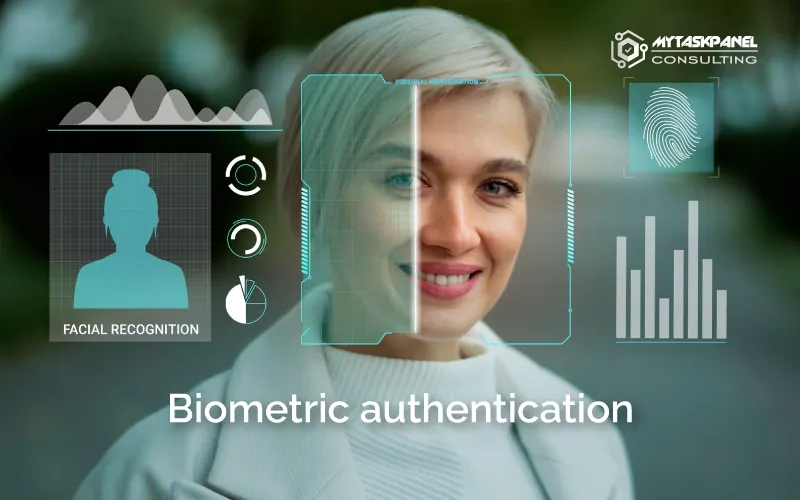Biometric authentication has become a key tool for enhancing security across various digital and physical platforms. By leveraging unique individual characteristics, such as fingerprints or facial recognition, this technology enables faster and more reliable identification compared to traditional methods. In this article, we will discuss how it works, its advantages and disadvantages, and some examples of its application in different sectors.
How does biometric authentication work?
Biometric authentication operates by analyzing and recognizing an individual’s unique physical or behavioral characteristics. Its general functioning is divided into several phases:
1. Biometric data capture
At this stage, a specialized sensor collects the biometric feature that will be used for authentication. Some examples include:
- Fingerprint scanner: captures the image of fingerprint ridges and valleys.
- Facial recognition camera: analyzes facial structure and features.
- Iris scanner: uses infrared light to detect unique iris patterns.
- Microphone for voice recognition: identifies tone, intonation, and frequency patterns.
2. Processing and conversion into digital data
Once captured, the biometric data is processed and converted into digital information through recognition algorithms. Biometric templates are generated, which are unique mathematical representations of the captured traits.
3. Storage and comparison
Biometric templates are stored in secure databases or local devices. During authentication, the system compares the newly captured sample with the stored template to verify the user’s identity.
4. Authentication and response
If the comparison between the biometric sample and the stored template falls within an acceptable margin, access is granted. Otherwise, the user is not recognized, and access is denied.
Examples of biometric authentication applications
Biometric authentication has been implemented across a wide range of industries and applications to enhance security and user convenience.
Mobile device security
- Apple Face ID and Touch ID: allow users to unlock their devices, authorize purchases, and access secure apps using facial recognition or fingerprint scanning.
- Samsung Ultrasonic Fingerprint Scanner: an ultrasonic fingerprint scanner integrated into Galaxy device screens that enhances accuracy and security.
Physical access control
- Access control systems in offices and buildings: companies and government agencies use fingerprint scanners, facial recognition, or iris scanners to restrict access to sensitive areas.
- Airports and immigration: facial recognition is used in airports worldwide to streamline border control and enhance security for international travel.
Authentication in financial services
- Banks and payment apps: financial institutions have implemented biometric authentication to validate transactions and prevent fraud. For example, some banking apps require facial recognition to authorize payments.
- ATMs with iris recognition: in some countries, ATMs use iris scanning instead of physical cards and PINs to identify users.
Healthcare applications
- Access to medical records: hospitals and clinics use biometric authentication to restrict access to medical files and ensure patient privacy.
- Patient tracking: some systems allow biometric identification of patients to prevent errors in treatment administration.
Use in retail and entertainment
- Personalized in-store experience: some brands use facial recognition to personalize customer experiences and offer recommendations based on past purchases.
- Access to events and stadiums: biometric authentication systems streamline entry to concerts, stadiums, and other large-scale events, eliminating the need for physical tickets.
Advantages and disadvantages of biometric authentication
Advantages
- Increased security: biometric traits are unique to each person, reducing the risk of identity theft.
- Convenience and speed: no need to remember passwords or carry physical cards, speeding up authentication processes.
- Difficult to replicate: unlike passwords or cards, fingerprints, faces, and irises are hard to copy.
- Integration across multiple industries: implemented in banking, healthcare, security, and entertainment sectors.
Disadvantages
- Potential vulnerability to sophisticated attacks: while biometric data is hard to forge, some systems can be tricked using photos, voice recordings, or fingerprint molds.
- Privacy concerns: storing biometric data poses security risks if databases are compromised.
- False positives and negatives: no system is 100% accurate, and identification errors can occur.
- Implementation costs: installing biometric sensors and systems can be expensive for some businesses.
Biometric authentication has become an advanced solution for enhancing security and accessibility across multiple sectors. From mobile devices to banking systems and airports, its adoption continues to grow. However, balancing the benefits with privacy and security challenges is crucial to ensuring responsible use of this technology. With ongoing advancements in artificial intelligence and data processing, biometric authentication will continue to evolve, offering increasingly secure and efficient identification methods.

